43 F. average high on March 23.
38 F. high on March 23, 2016.
2" snow at STC so far this month.
7" average monthly snowfall, as of March 23.
March 24, 1851: Minnesota experiences an early spring 'heat wave' with 60s and 70s common.
Another Warmer, Wetter Year for Minnesota?
"Don’t knock the weather; nine-tenths of the people couldn’t start a conversation if it didn’t change once in a while" wrote Kin Hubbard.
The forecast? "Changeable". Back to you, Earl.
People ask me what I think 2017 will be like in Minnesota. Rule number one: "persistence". Go with the flow. Don't buck the trends. Odds favor another warmer, wetter year. A few major flash flood events are likely. Higher dew points will fuel thunderstorms with damaging hail, maybe a long-lasting derecho or two. This is already the busiest year for tornadoes in the USA since 2008. By April you'll want to review your family's severe weather plan - it's good to be prepared.
A sprawling storm sparking severe weather over the southern Plains brushes us with showers today. We dry out this weekend but a cool, damp northeast breeze will discourage shorts and T-shirts. It's still a little early to put in the dock or plant annuals.
Long-range models pull 50s back into Minnesota next week; NOAA's GFS model shows 60s and 70s in roughly 2 weeks.
Spring is imminent. Take that forecast to the bank!
April temperature anomaly outlook above courtesy of NOAA and WeatherBell.
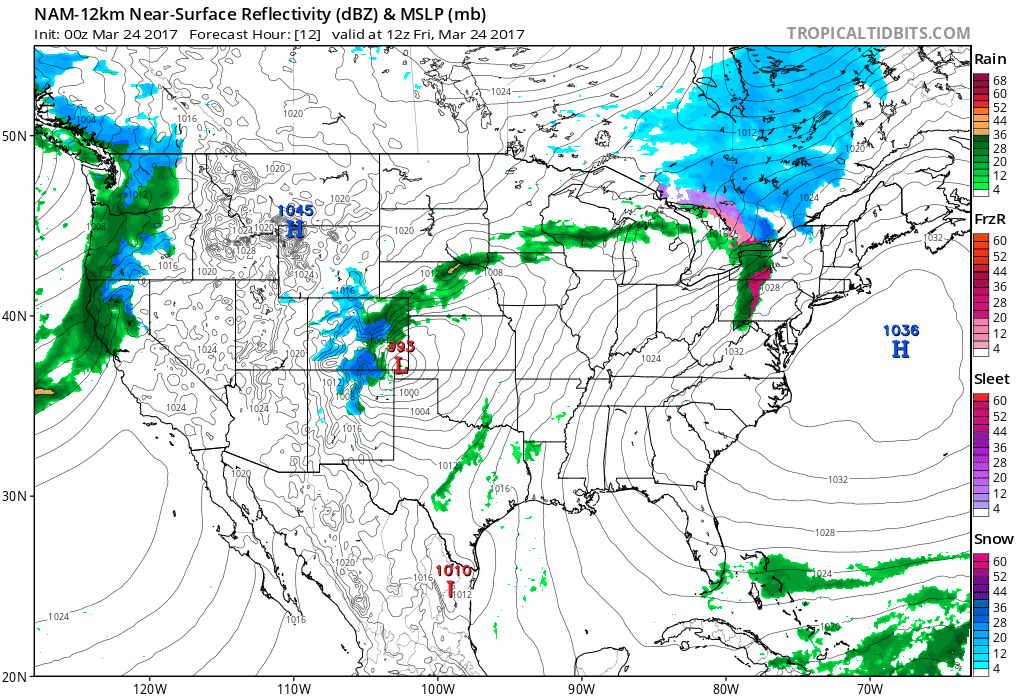
Wintry Slap for the Front Range. Oh to be in Denver. On Thursday the high temperature in the Mile High City reached a record 77F, that's 20F warmer than average. Today it will snow (hard) with winds gusting over 45 mph; blizzard conditions possible - especially south and southeast of downtown Denver. An amazing case of weather whiplash. Meanwhile (spoiler alert) another sloppy front pushes into the western USA with more heavy rain, while heavy snow gradually tapers over New England. All vivid reminders that Old Man Winter won't go quietly. NAM Future Radar: NOAA and Tropicaltidbits.com.
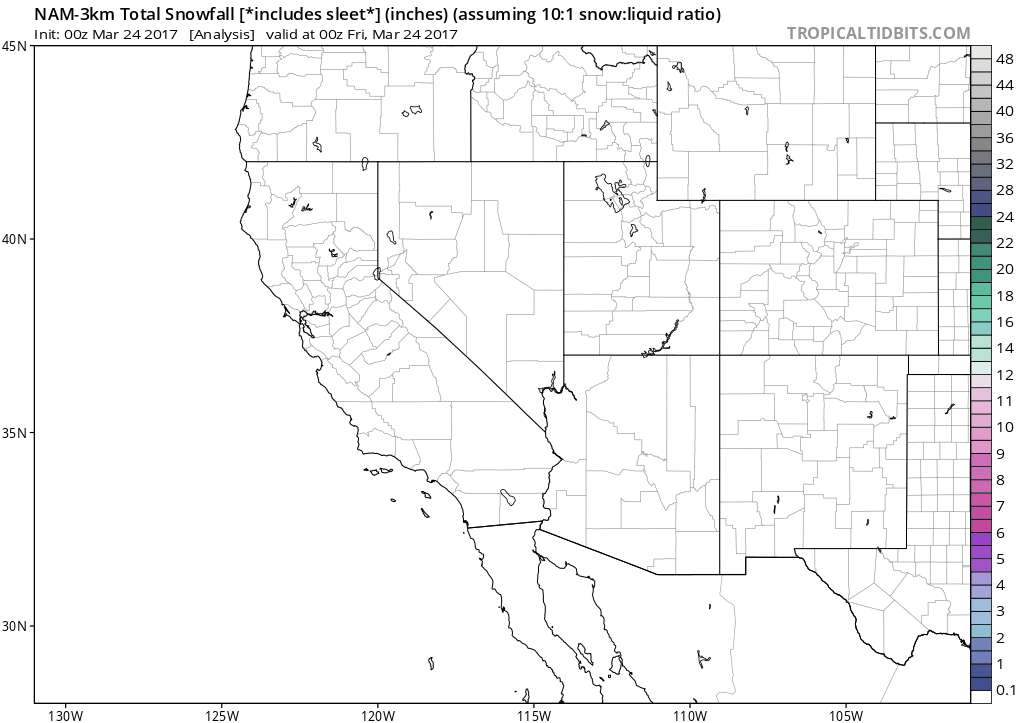
Snowfall Potential. NOAA's (new) 3KM NAM model shows the heaviest snow bands setting up along and south of I-70 near Denver; the best chance of white-out conditions south and east of downtown, from Castle Rock and Deer Trail to Limon.
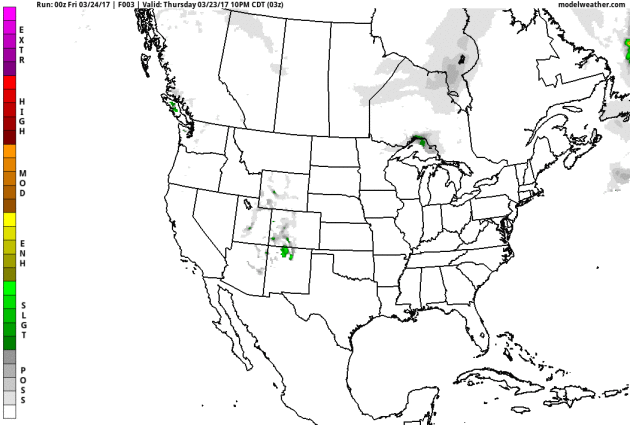
Slight Severe Storm Risk Southern Plains. In the warm sector of the same storm whipping up a blizzard for Colorado conditions look more favorable for a more widespread severe storm outbreak than we saw yesterday. Today Tulsa, Little Rock, Shreveport, Dallas and Houston may be under the gun. The 15% highlighted area means a 15 percent risk of severe weather within 25 miles of any point. Map: NOAA SPC.
New Cloud Types Defined by WMO. The UK Met Office has details: "The cloud species Volutus has been officially named as a new species of cloud in the World Meteorological Organization’s Cloud Atlas. The new cloud species name will now be used by meteorologists operationally around the world. As well as a new species, several new ‘special clouds’ and supplementary features of existing cloud types have been officially recognised in the atlas which is the official publication of cloud types. It is used as a reference document by operational meteorologists around the world and is also an important training tool for meteorologists, as well as for those working in aviation and at sea. Special clouds named in the new edition include: Flammagenitus, which are clouds formed as a result of forest fires; and Homogenitus, which denotes man-made or anthropogenic clouds such as those which form over power station cooling towers. An example of a new supplementary feature is Asperitas, which are well defined wave-like structures in the underside of clouds..."
More new entries in the WMO (World Meteorological Organization) Cloud Atlas:
Clouds
may also develop as a consequence of human activity. Examples are
aircraft condensation trails (contrails), or clouds resulting from
industrial processes, such as cumuliform clouds generated by rising
thermals above power station cooling towers. Clouds that are clearly
observed to have originated specifically as a consequence of human
activity will be given the name of the appropriate genus, followed by
the special cloud name “homogenitus”. For example, Cumulus cloud formed
above industrial plants will be known as Cumulus (and, if appropriate,
the species, variety and any supplementary features) followed by the
special cloud name homogenitus; for example, Cumulus mediocris homogenitus. - See more at: https://www.wmocloudatlas.org/homogenitus.html#sthash.WGzVNilv.dpuf
Clouds
may also develop as a consequence of human activity. Examples are
aircraft condensation trails (contrails), or clouds resulting from
industrial processes, such as cumuliform clouds generated by rising
thermals above power station cooling towers. Clouds that are clearly
observed to have originated specifically as a consequence of human
activity will be given the name of the appropriate genus, followed by
the special cloud name “homogenitus”. For example, Cumulus cloud formed
above industrial plants will be known as Cumulus (and, if appropriate,
the species, variety and any supplementary features) followed by the
special cloud name homogenitus; for example, Cumulus mediocris homogenitus. - See more at: https://www.wmocloudatlas.org/homogenitus.html#sthash.WGzVNilv.dpuf
Another El Nino Brewing? According to NOAA NCEP ENSO-neutral may morph into another El Nino warm phase in the Pacific by late summer and autumn.
Most Active Start to Tornado Season Since 2008. Thanks to Johnny Kelly for passing this nugget along.
Map credit: "Sea surface temperature difference from average." (WeatherBell.com)
Freezing Temperatures Devastate South Carolina Farmers. More details via South Carolina Department of Agriculture: "Last
week, temperatures dipped to record lows and now South Carolina peach
farmers face the worst crop damage they have seen in ten years.
Strawberries and blueberries were among other crops damaged during the
freeze. Members of the South Carolina Peach Council and other industry
representatives met Monday morning to discuss the severity of the damage
to the peach crop, which was in early bloom due to an unseasonably warm
winter. Farmers are hopeful to have ten to fifteen percent of their
usual crop. Peach-lovers can still expect to see local peaches in July
and August in limited quantities. Statewide, strawberries have
experienced about a fifteen percent loss. Midland and Upstate blueberry
farmers are reporting significant loss, similar to that of peaches.
Information is still being gathered from blueberry farms in the lower
part of the state..."
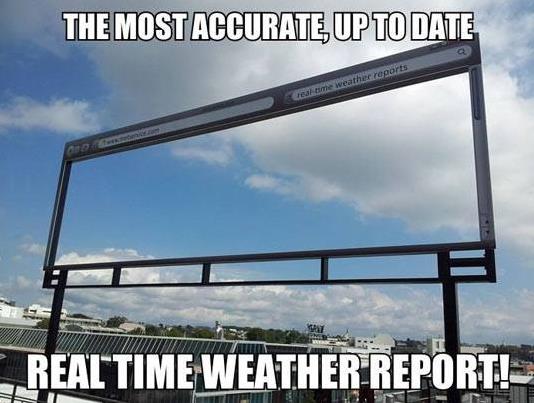
Why People Think Weather Forecasts Are Bad When They Are Actually Pretty Good. Dr. Marshall Shepherd explains weather-accuracy perception vs. reality at Forbes: "...The
reality is that modern-day weather forecasts are pretty accurate so I
decided to explore reasons people think they are bad. A field goal
kicker could make every single kick during football season, but what if
he misses the "big one" in the championship bowl game? He may be
ridiculed or criticized, but is he a bad kicker? Probably not, but he
did miss a kick with great impact. Weather forecast outcomes are very
similar. The March Blizzard of 2017 happened.
It really did. However, a vigorous debate ensued on whether it was a
"bust" because it did not produce snowfall totals and blizzard
conditions in the big cities along the I-95 corridor. Some argued that forecasters adequately conveyed the uncertainty with the forecast while others suggested that
the National Weather Service made some errors in leaving Blizzard
warnings up in the big cities though models seemed to be backing off..."
Photo credit: "Not an ideal neighbor." (AP Photo/Gerry Broome).
Healthcast: Air Quality Impacts Exercise. Outdoor air pollution is the world's biggest killer, claiming more lives, worldwide, than malaria and HIV/AIDS. Praedictix.com meteorologist Kristin Clark reports: "Now a new study
finds that simply exercising outdoors in poor air quality can be more
detrimental to your health than not exercising at all. Researchers
reveal that in some cities air pollution levels have increased to the
point where just 30 minutes of cycling outweigh the benefits of the
exercise altogether. As a cyclist myself this is a surprising stat.
Seems counterintuitive, right? Exercise, no matter in what environment,
should be good for our body and our overall health, right? Wrong. Air
pollution is so bad in certain areas that even walking poses a serious
health threat. Granted this finding holds true for only the most polluted cities on Earth. Zabol, Iran and Gwalior, India are the top two most polluted cities in the world according to the World Health Organization (WHO). More than 80% of people living in low-income cities that monitor air pollution are exposed to air quality levels that exceed WHO limits..."
Image credit: "Scale of PM2.5 particles. The human hair is 30 times larger than fine particles." Source: EPA
Map credit: "If only Eisenhower had known… he would totally have still built these roads." (Bureau of Transportation Statistics)
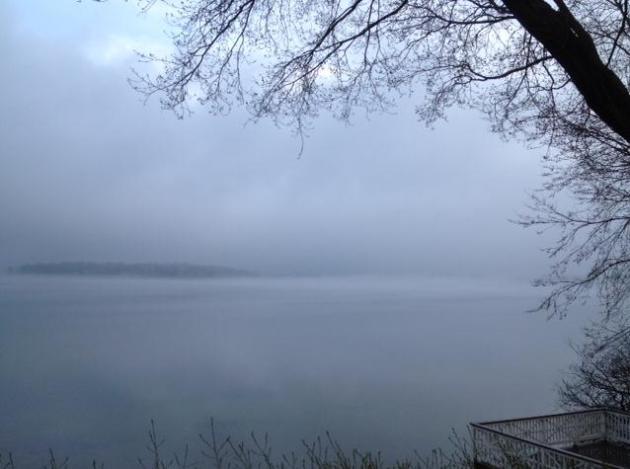
Photo credit: "Residents of Pueblo protest high electric rates." CREDIT: Pueblo’s Energy Future
Image credit: "In the next decade, the energy storage industry will go from the familiar, like the iPhone, into much bigger applications like electric cars and the power grid." Photos courtesy of the Pacific Northwest National Laboratory, Pixabay, Dave Dugdale/Flickr (Tesla).
Image credit: BBC

Job-Stealing Robots? Millennials See Hope, Fear in Automation. Every threat is an opportunity, right? Here's a clip from LinkedIn: "...Dramatic shifts in the how and the where of the future of work recently prompted my 15-year-old to ask, “Mom, are robots going to take my job someday?” Timely question. Deloitte Global’s latest survey of millennials shows many are asking the same thing. While they recognize the benefits of automation in terms of productivity and economic growth, they also see it providing opportunities for value-added or creative activities, or learning new skills:
- 40 percent see automation posing a threat to their jobs;
- 44 percent believe there will be less demand for their skills;
- 51 percent believe they will have to retrain; and
- 53 percent see the workplace becoming more impersonal and less human. Which is news that should make every CEO sit up and take notice, given this generation’s use of social media..."
Let Robots Handle Your Emotional Burnout at Work.
Then again, maybe robotics and automation will keep us from going
crazy? Here's an excerpt of a more hopeful perspective on automation at How We Get To Next: "...Over
three decades later, working in a service job still demands the stamina
and resilience to handle a barrage of customer complaints—and often
even abuse—with a smile. Professions that require emotional labor, which
involves inducing or suppressing emotion for the sake of a job,
continue to see unprecedented levels of attrition, especially among customer service representatives, flight attendants, doctors, nurses, school teachers, and hotel employees.
But as robotics and computing evolve, some researchers foresee a future
where technology can relieve the long-held emotional burden of some of
these professions. They think we owe it to the service workforce to
offer a new frontline of robotic protection. In fact, they think it’s
far overdue—but does that actually mean just automating these jobs away?..."
Image credit: Darren Garrett
Image credit: Wikimedia / donatas1205 / Billion Photos / vgeny Karandaev / The Atlantic.
TODAY: Cool and showery. Winds: NE 8-13. High: 46
FRIDAY NIGHT: Showers taper over southern Minnesota. Low: 35
SATURDAY: Mostly cloudy, drying out with peeks of sun. Winds: NE 10-15. High: near 50
SUNDAY: More clouds than sun, quiet. Winds: NE 5-10. Wake-up: 36. High: 49
MONDAY: Lingering clouds, a little drizzle. Winds: NW 5-10. Wake-up: 38. High: 48
TUESDAY: Partly sunny and milder. Winds: NW 5-10. Wake-up: 36. High: 55
WEDNESDAY: Few complaints. Intervals of sun. Winds: S 5-10. Wake-up: 38. High: 54
THURSDAY: Mix of clouds and sun, springier. Winds: S 8-13. Wake-up: 40. High: 58
Climate Stories...
Image credit: "On March 7, Arctic sea ice hit a record low wintertime maximum extent." (L. Perkins/NASA Goddard Scientific Visualization Studio).
Accelerating Meltdown. From Climate Nexus: "For the third year running, Arctic sea ice hit a record low for its annual peak extent of winter ice cover, scientists reported Wednesday. According to the National Snow and Ice Data Center (NSIDC), sea ice cover reached its peak extent on March 7 at 5.57 million square miles – over 470,000 square miles, an area the size of South Africa, smaller than the 1981-2010 long-term average, and 37,000 square miles smaller than the 2015 record. The meager ice cover comes after a disturbingly warm winter in the region, and NSIDC reports temperatures 4.5°F above average from October to February. The ice is "a key part of the Earth's climate system and we're losing it," NSDIC director Mark Serreze told the AP. "We're losing the ice in all seasons now."
* The 28 page WMO (World Meteorological Organization) report on the climate is here.
More Extreme Weather Coming After Record 2016 Heat, WMO Says. Bloomberg provides more perspective on the WMO report: "Unusually warm weather in the Arctic is helping shift weather patterns this year from North America to the Middle East, after global warming shattered records in 2016, according to the World Meteorological Organization. Rising ocean temperatures that are melting polar ice sheets, killing marine life and flooding coastal communities may have increased more than previously reported last year, the WMO said in a report Tuesday. Average sea-surface temperatures hit their highest levels ever last year, and overall temperatures over sea and land were 1.1 degrees Celsius above the pre-industrial period. At least three times this winter, the Arctic has experienced the polar equivalent of a heat wave with Atlantic storms driving warm, moist air..." (Map credit: NOAA NCDC).
Photo credit: "Rep. Carlos Curbelo, R-Fla., speaks to reporters at the Capitol about climate change on Monday, March 20, 2017. He is flanked by Republican Reps. Mark Sanford of South Carolina (from left), Brian Mast and Ileana Ros-Lehtinen of Florida and Ryan Costello of Pennsylvania." Curtis Tate McClatchy
Climate Change is Certainly Causing More Powerful Storms. Here's a clip from an article at Salon: "...The ‘100-year flood’ now occurs more often than once a century,” Hansen said. Michael E. Mann, Director of the Earth System Science Center and Distinguished Professor of Meteorology at Penn State University, observed that the warming climate is actually causing more snow. “The oceans have been at record levels of warm the past two years (and climate change is a key contributor to that),” Mann said. “That record warmth means that there is more moisture in the atmosphere that is available both to help strengthen the storm and produce record snowfalls as the warm oceanic air is entrained in toward the eastern U.S. by the cyclonic winds of the storm. Climate model simulations indicate a likelihood for stronger, more snow-making storms, and that’s what we’re seeing...”
Superstorm Sandy file imagery: Mel Shapiro, NCAR.
Here's How Climate Change is Already Affecting Your Health, Based on the State You Live In. Yahoo News has the story: "Climate change is already beginning to wreak havoc upon the planet. In the short term, we're facing more winter storms, miserably hot summers, and a longer allergy season. In the long term, entire coastlines will likely disappear, threatening communities and wildlife. On a more local level, experts say the US will be unrecognizable in 100 years. But just how is all of this affecting you — your state, your coastline — right now? A new report from the Medical Society Consortium on Climate and Health reveals
that different geographic regions in the US are facing a range of
effects, many of which are already taking shape today. Some of them are
as geographically specific as to affect only one state..."
The Seasons Aren't What They Used To Be. Here's an excerpt of a poignant piece at The New York Times: "...Spring has been particularly hasty and irregular this year, but this is no anomaly. In the latter half of the 20th century, the spring emergence of leaves, frogs, birds and flowers advanced in the Northern Hemisphere by 2.8 days per decade. I'm nearly 50, so springtime has moved, on average, a full two weeks sinnce I was born. And you? We now experience climate change not only through the abstraction of science, but also through lived experience..." (Image credit: NOAA).
No comments:
Post a Comment